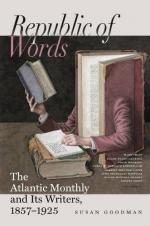The scenes of most of them are laid in the East,—of a few in Germany; but the robust method of the German story-writer is apparent in each. We wish we could quote from one or two which have particularly charmed us; but though this is impossible within any decent limits, we can at least provoke the appetite of readers of all ages by the mere displaying of such titles as these:—“The History of Caliph Stork”; “The Story of the Severed Hand”; “The Story of Little Muck”; “Nosey the Dwarf”; “The Young Englishman”; “The Prophecy of the Silver Florin”; “The Cold Heart,” etc. What prospects for winter evenings are here! And while we can assure the adult reader that the promise which these titles give of burlesque or humorous description, and bold, romantic narrative, shall be more than kept, it may be well also to say, for the comfort of those whom we hope to see buy the book for their children’s sake, that the stories in it are entirely free from certain objections which may be fairly urged against the “Arabian Nights” as reading for young people. The “Arabian Days” have nothing to be ashamed of in the nature of their entertainments.
The translation itself is a performance in a high degree creditable, not only to the German, but to the English, scholarship of Mr. Curtis. We perceive scarcely any of that peculiar stiffness of style which makes so many otherwise excellent translations painful to read,—the stiffness as of one walking in new boots,—the result of dressing the words of one language in the grammatical construction of another. Mr. Curtis gives us the sentiment and wit and fancy and humor and oddity of the German’s stories, but in an English way. Indeed, his is manly and graceful English, such as we hope we are not now by any means seeing the last of.
To the right sort of reader, as we consider him, of the “Arabian Days,” a word about the pictures (for observe, that the proper name for the illustrations of a story-book is pictures) may be fitly spoken.
There are no less than sixteen very nice pictures to this story-book,—well done, even for Mr. Hoppin, artistically, and well conceived for the refreshing of the inner eye of him, her, or it that reads. And we must be permitted, also, who have read this book by candle-light, as only such a book should be read, to congratulate the readers who come after us upon the good type and good paper in which the publishers have very properly produced it.
We hope and believe this publication will before long be given as a boon to the rising generation, our second-cousins, across the water. They, however, cannot have it (as we fully intend that certain small bodies, but huge feeders on fiction, among our acquaintance, shall have it) on Christmas morning,—the dear old festival, that, as we write, is already near enough to warm our hearts with anticipation.
* * * * *
The Stratford Gallery: or the Shakspeare Sisterhood. Comprising Forty-five Ideal Portraits, described by HENRIETTA LEE PALMER. Illustrated. New York: D. Appleton & Co.




